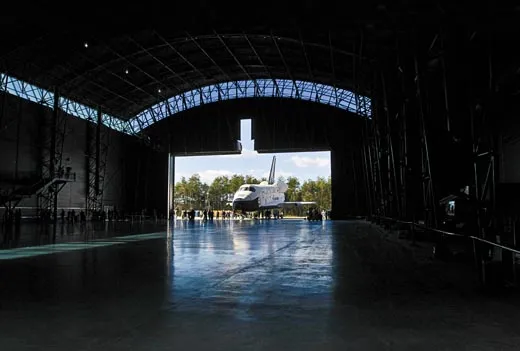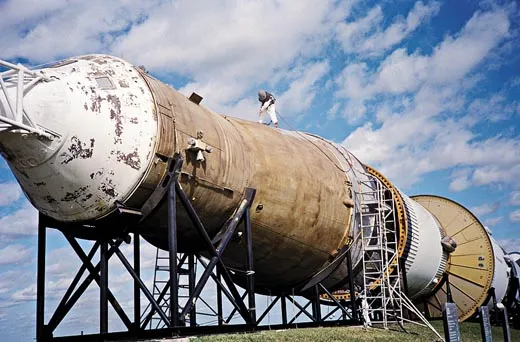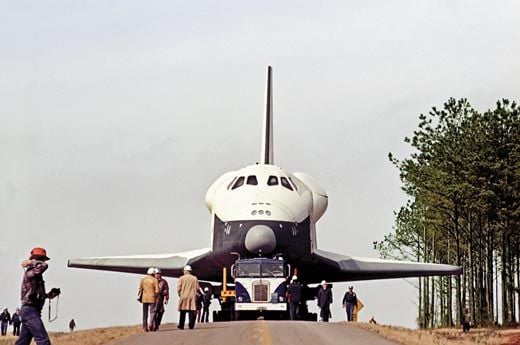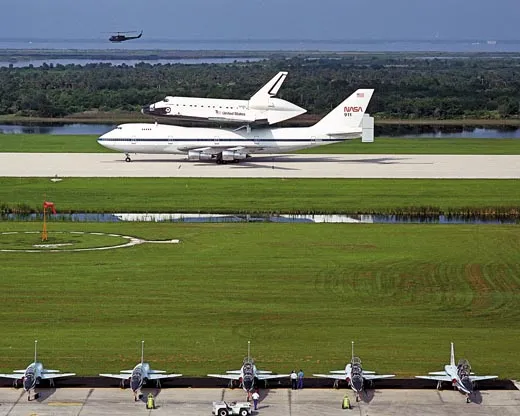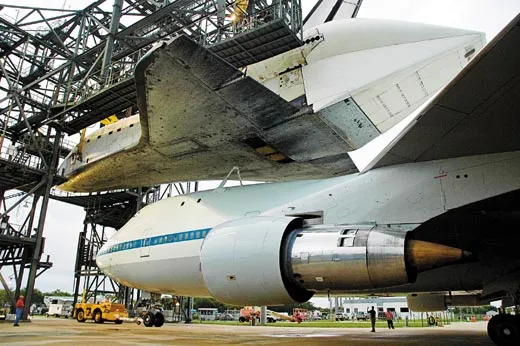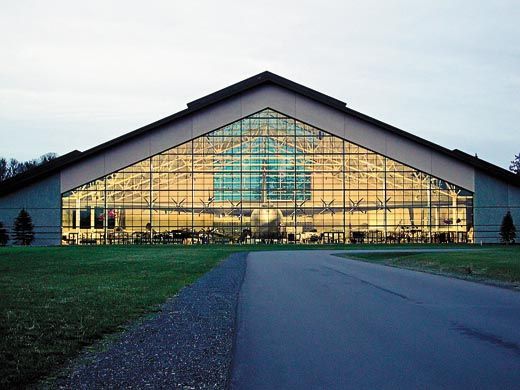Shuttles For Sale
Three orbiters in search of good homes. Not cheap.
/https://tf-cmsv2-smithsonianmag-media.s3.amazonaws.com/filer/Shuttle_Flash_Space_FM10.jpg)
Want the ultimate space collectible? Consider a space shuttle. The orbiters have flown 29 years and have a few miles on them (tens of millions), but soon all three will be up for grabs.
Some time this year—right now it looks like September 30—NASA plans to shut down the program. For all the shuttle’s successes in missions like deploying satellites, fixing the Hubble Space Telescope, and building the International Space Station, flying it was always risky. Two orbiters were lost, Challenger in 1986 and Columbia in 2003, killing 14 astronauts. Now NASA says it will donate the ones remaining— Atlantis, Discovery, and Endeavour—to whoever it feels can provide the best homes. In 2008, the agency issued a Request for Information, and21 institutions entered the competition. NASA won’t say when it will ask for formal proposals or identify the candidates, but some have declared themselves, apparently feeling that if you want a national treasure, you shouldn’t be shy about saying so.
NASA made it clear that contestants don’t win simply by raising their hands. Only U.S. museums and educational institutions are eligible. And the gift shuttles will not come with the three main engines, making them lighter and thus easier to transport. (NASA plans to give away six to 10 unassembled engine “kits” to suitable museums.)
Also, you have to display the orbiter indoors. NASA clearly wants to avoid a repeat of the Apollo program’s denouement, when the agency left its three remaining Saturn V rockets to decay outside for decades at its centers in Florida, Texas, and Alabama. These noble behemoths, once targets for pigeons, have since been restored but “certainly there was a lesson learned,” says Valerie Neal, shuttle curator at the National Air and Space Museum, which owns the rockets. Spacecraft are fine in a vacuum, she points out, “but they don’t do that well on Earth. Both NASA and the Museum were a little naïve.”
Most important, acquiring a shuttle orbiter is expensive. NASA is requiring the winners to come up with $28 million— just for shipping and handling. (Note: The figure was reduced from $42 million after our March issue went to press) Orbiters are122 feet long, weigh 151,000 pounds, and have 78-foot wingspans. Underbellies are padded with ceramic thermal tiles, which must remain intact. The spacecraft cannot be disassembled for transport.
The first $6 million of the fee will reimburse NASA for the Boeing 747 that will piggy back an orbiter to the airport of choice—as long as it’s one with a runway at least 8,000 feet long. NASA hopes to get all three piggy backs done by May 31, 2012. Everything after that is your problem, and the ante doesn’t cover any of it. You must get the orbiter to the facility you have built for it, clean it up, put it indoors, fix up the displays, train the guides, and set up the videos and other exhibit features.
The document warned that during the move NASA will not “remove light posts and traffic signals,” a point that caused the Kansas Cosmosphere and Space Center to drop out. There were suitable airports in Salina and Wichita, but to reach the Hutchinson museum, the orbiter would have had to travel 50miles over two-lane roads. “We didn’t want to destroy a highway,” says Marisa Honomichl, the Cosmosphere’s vice president of marketing and development.
NASA did not say what the $28 million buys you, but most of the money will be used to “safe” the orbiter: doing such things as covering naked wires, loose gadgets, and sharp edges, and draining it of toxic fluids.
There are several ways to raise $28 million quickly— a new tax, vanity license plates, a special appropriation. “We would welcome public funding,” says Stewart Bailey, curator of Oregon’s Evergreen Aviation & Space Museum. But if that doesn’t come through, he says, “we won’t be holding a bake sale.”
The Evergreen museum is anon-profit owned by Evergreen International Aviation Inc., a conglomerate that specializes in air transport, air cargo, and ground infrastructure but that also owns vineyards, farmland, and pasture near its headquarters in McMinnville, about 35 miles from Portland.
Evergreen opened the museum in 1991 and now has more than 100 aircraft on display. Its prize attraction is Howard Hughes’ Spruce Goose, an airplane with a wingspan wider than the Airbus A380’s; it bought the flying boat from Disney in 1992. And it has a new 121,000-square-foot building just waiting for a tenant.
“We understand the challenges; they are very clear,” says Bailey. “The orbiter is big, it’s hard to move, and it’s expensive, but we wanted to be ready, and we are.”Evergreen barged the Goose to McMinnville, waiting for low tide to sneak the cargo under bridges. The same technique should work for the shuttle, but if not, the company will figure something out. Moving big stuff, Bailey notes, is what they do.
Also unworried is the National Air and Space Museum. Based on the RFI, the Museum is virtually guaranteed first pick, and Neal says it plans to request Discovery, the oldest of the three shuttles. The Museum will almost certainly make its shuttle on display, Enterprise, available to another museum. Now at the Museum’s Steven F. Udvar-Hazy Center, Enterprise was a prototype, flown only in atmospheric drop tests, not in space.
Still, for some candidates, it’s not just about the money. New York’s Intrepid Sea, Air & Space Museum, at the piers of downtown Manhattan, has in its favor location, a huge metro region, and legions of tourists. The museum would house the shuttle in a glass enclosure on the end of Pier 86 at 46th Street.
The museum “is uniquely positioned to be the recipient of one of these national treasures,” says Bill White, president of the foundation that operates it. Getting the money wouldn’t seem to be a problem; the Intrepid foundation raised $115 million for the recent overhaul of the carrier and its pier (see “Restoration: Cleaning a Carrier,” Aug./Sept.2008) and to cover two years’ operating costs. Now the Intrepid is raising more for a shuttle; officials won’t say how much.
On the other coast, Seattle’s Museum of Flight has Bonnie Dunbar, a former astronaut, as president and CEO, and is located in one of the cradles of American aviation. And the museum butts up against Boeing Field/King County International Airport.
Dunbar says her museum is building an exhibit hall that could house the orbiter. As for the$42 million entry fee, “It is twice as much as the new building will cost, and quite a surprise,” she says. But she adds: “I think it’s all negotiable—and it should be.”
If so, Museum of Flight, with its larger market, might have an advantage over Evergreen, but Bailey remains undaunted. Evergreen built the new facility partly as a Field of Dreams impulse: If you build it, the shuttle will come. When it comes to exhibits, he says, “we don’t do penny-ante stuff.” Probably the right attitude.
Guy Gugliotta is a writer in Pelham, New York.
